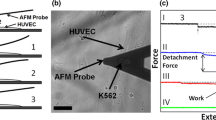Abstract
Human polymorphonuclear leukocytes (PMN) were found to tightly adhere on endothelial (lines EAhy926 and ECV304) and collagen surfaces under the influence of the chemotherapeutic drug suramin. This was observed by scanning electron microscopy and quantitated by myeloperoxidase assays. Suramin also inhibited Ca2+ ionophore A23187-stimulated leukotriene (LT) synthesis in PMN interaction with endothelial cells or with collagen surface. Suramin decreased the release of radiolabeled arachidonic acid (AA) and 5-lip-oxygenase (5-LO) metabolites by prelabeled PMN stimulated with A23187. Using agents releasing the suramin-stimulated adhesion namely jasplakonolide and dextran sulfate, we observed a reversal of the suramin effect on leukotriene synthesis. Jasplakonolide released the adhesion of PMN on endothelial and collagen-coated surfaces and restored 5-LO activity. Dextran-sulfate released adhesion on collagen-coated surfaces and abolished suramin inhibition. Arachidonate could also overcome adhesion and inhibition of 5-LO. We conclude that suramin-induced tight attachment of PMN on to solid surfaces lead to decreased leukotriene synthesis during subsequent A23187 stimulation in the absence of exogenous substrates.
Similar content being viewed by others
REFERENCES
Borgeat, P., and Samuelsson, B. (1979) Arachidonic acid metabolism in polymorphonuclear leukocytes: Effects of ionophore A23187. Proc. Natl. Acad. Sci. USA 76:2148–2152.
Ford-Hutchinson, A. W. (1990) Leukotriene B4 in inflammation. Crit. Rev. Immunol. 10:1–14.
Samuelsson, B. (1983) Leukotrienes: mediators of immediate hypersensitivity reactions and inflammation. Science (Wash. DC) 220:568–575.
Dahlen, S. E., Hedqvist, P., Hammarstrom, S., and Samuelsson, B. (1980) Leukotrienes are potent constrictors of human bronchi. Nature (Lond.) 288:484–486.
Engler, R. L., Dahlgren, M. D., Morris, D. D., Peterson, M. A., and Schmid-Schonbein, G. W. (1986) Role of leukocytes in response to acute myocardial ischemia and reflow in dogs. Am. J. Physiol. 251:(2 Pt2), H314-H323.
Mehta, J. L., Nichols, W. W., and Mehta, P. (1988) Neutrophils as pootential participants in acute myocardial ischemia: relevance to reperfusion. J. Am. Coll. Cardiol. 11:1309–1316.
Hale S. L. (1993) role of leukocytes in reperfusion in jury. In: Ischemia-reperfusion in cardiac surgery (Piper, H. M., and Preusse, C. J., Eds.), Kluwer Academic Publishers, Dordrecht. pp. 67–80.
Simpson, P. J., Todd, R. F. III, Fantone, J. C., Mickelson, J. K., Griffin, J. D., and Lucchesi, B. R. (1988) Reduction of experimental canine myocardial reperfusion injury by a monoclonal antibody (anti-Mol, anti-CD11b) that inhibits leukocyte adhesion. J. Clin. Invest. 81:624–629.
Byrne, J. G., Smith, W. J., Murphy, M. P., Couper, G. S., Appleyard, R. F., and Cohn, L. H. (1992) Complete prevention of myocardial stunning, contracture, low-reflow, and edema after heart transplantation by blocking neutrophil adhesion molecules during reperfusion. J. Thorac. Cardiovasc. Surg. 104:1589–1596.
Ginis, I., Mentzer, S. J., Xiopu, L. I., and Faller, D. V. (1995) Characterization of a hypoxia-responsive adhesion molecule for leukocytes on human endothelial cells. J. Immunol. 155:802–810.
Sud'ina, G. F., Mirzoeva, O. K., Galkina, S. I., Pushkareva, M. A., and Ullrich, V. (1998) Involvement of ecto-ATPase and extracellular ATP in polymorphonuclear granulocyte—endothelial interactions. FEBS Lett. 423:243–248.
Stein, C. A. (1993) Suramin: a novel antineoplastic agent with multiple potential mechanisms of action. Cancer Res. 53:2239–2248.
Baghdiguian, S., and Fantini, J. (1997) Suramin: a molecule with a broad spectrum of biological and therapeutic properties. Cancer J. 10:31–37.
Freyer, D. R., Boxer, L. A., Axtell, R. A., and Todd, R. F. (1988) Stimulation of human neutrophil adhesive properties by adenine nucleotides. J. Immunol. 141:580–586.
Parker, A. L., Likar, L. L., Dawicki, D. D., and Rouds, S. (1996) Mechanism of ATP-induced leukocyte adherence to cultured pulmonary artery endothelial cells. Am. J. Physiol. 270:(5 Pt1), L695–703.
Edgell, C. J., McDonald, C. C., and Graham, J. B. (1983) Permanent cell line expressing human factor VIII-related antigen established by hybridization. Proc. Natl. Acad. Sci. USA 80:3734–3737.
Bath, P. M., Booth, R. F., and Hassall, D. G. (1989) Monocyte-lymphocyte discrimination in a new microtitre-based adhesion assay. J. Immunol. Meth. 118:59–65.
Schierwagen, C., Bylund-Fellenius, A. C., and Lundberg, C. (1990) Improved method for quantitation of tissue PMN accumulation measured by myeloperoxidase activity. J. Pharmacol. Meth. 23:179–186.
Dawson, N. A., Lush, R. M., Steinberg, S. M., Tompkins, A. C., Headlee, D. J., and Figg, W. D. (1996) Suramin-induced neutropenia. Eur. J. Cancer 32A:1534–1539.
Bubb, M. R., Senderowicz, A. M. J., Sausville, E. A., Duncan, K. L. K., and Korn, E. D. (1994) Jasplakinolide, a cytotoxic natural product, induces actin polymerizatioin and competitively inhibits the binding of phalloidin to F-actin. J. Biol. Chem. 269:14869–14871.
Hovard, T. H., and Watts, R. G. (1994) Actin polymerization and leukocyte function. curr. Opin. Hematol. 1:61–68.
Sheikh, S., and Nash, G. B. (1996) Continuous activation and deactivation of integrin CD11b/CD18 during de novo expression enables rolling neutrophils to immobilize on platelets. Blood 87:5040–5050.
Sheikh, S., and Nash, G. B. (1998) Treatment of neutrophils with cytochalasins converts rolling to stationary adhesion on P-selectin. J. Cell. Pysiol. 174:206–216.
Kelbe, R. J., and Mock, P. J. (1982) Effect of glycosaminoglycans on fibronectin-mediated cell attachment. J. Cell. Physiol. 112:5–9.
Peters-Golden, M. (1998) Cell biology of the 5-lipoxygenase pathway. Am. J. Respir. Crit. Care Med. 157:S227-S232.
Brock, T. G., McNish, R. W., Bailie, M. B., and Peters-Golden, M. (1997) Rapid import of cytosolic 5-lipoxygenase into the nucleus of neutrophils after in vivo recruitment and in vitro adherence. J. Biol. Chem. 272:8276–8280.
Richards, C. F., Johnson, A. R., Campbell, W. B. (1986) Specific inforporation of 5-hydroxy-6,8,11,14-eicosatetraenoic acid into phosphatidylcholine in human endothelial cells. Biochim. Biophys. Acta 875:569–581.
Bazan, N. G. (1970) Effects of ischemia and electroconvulsive shock on free fatty acid pool in the brain. Biochim. Biophys. Acta 218:1–10.
Bazan, N. G., and Rodriguez de Turco, E. B. (1980) Membrane lipids in the pathogenesis of brain-edema: phospholipids and arachidonic acid, the earliest membrane components changed at the onset of ischemia. Adv. Neurol. 28:197–205.
Bazan, N. G. (1989) Arachidonic acid in the modulation of excitable membrane function and at the onset of brain damage. Ann. NY Acad. Sci. 559:1–16.
Author information
Authors and Affiliations
Rights and permissions
About this article
Cite this article
Sud'ina, G.F., Pushkareva, M.A., Galkina, S.I. et al. Effects of Suramin on PMN Interactions with Different Surfaces. Biosci Rep 19, 547–558 (1999). https://doi.org/10.1023/A:1020214928298
Issue Date:
DOI: https://doi.org/10.1023/A:1020214928298



